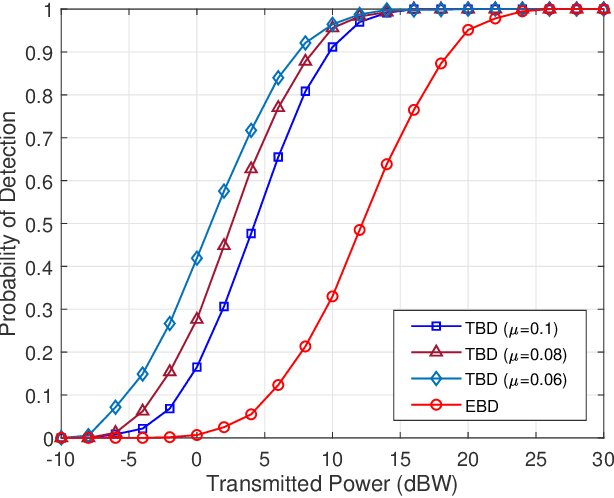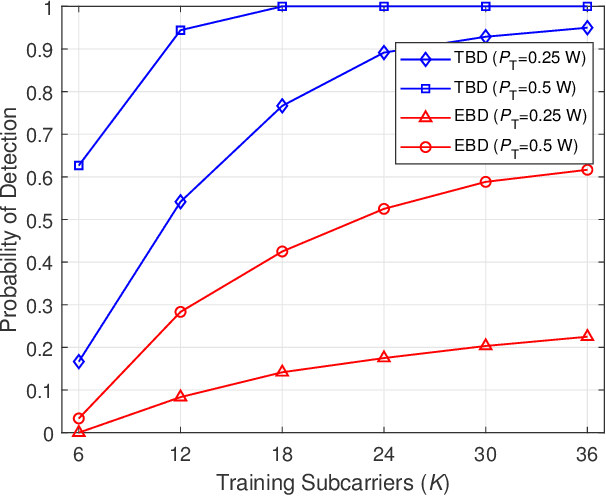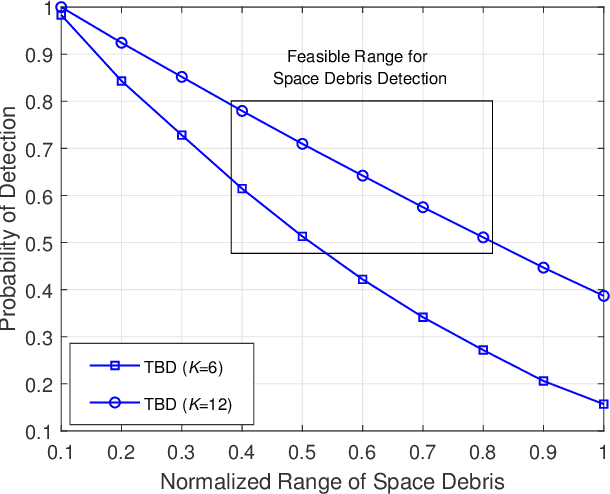Hasan Nayir
Tensor-based Space Debris Detection for Satellite Mega-constellations
Nov 20, 2023



Abstract:Thousands of satellites, asteroids, and rocket bodies break, collide, or degrade, resulting in large amounts of space debris in low Earth orbit. The presence of space debris poses a serious threat to satellite mega-constellations and to future space missions. Debris can be avoided if detected within the safety range of a satellite. In this paper, an integrated sensing and communication technique is proposed to detect space debris for satellite mega-constellations. The canonical polyadic (CP) tensor decomposition method is used to estimate the rank of the tensor that denotes the number of paths including line-of-sight and non-line-of-sight by exploiting the sparsity of THz channel with limited scattering. The analysis reveals that the reflected signals of the THz can be utilized for the detection of space debris. The CP decomposition is cast as an optimization problem and solved using the alternating least square (ALS) algorithm. Simulation results show that the probability of detection of the proposed tensor-based scheme is higher than the conventional energy-based detection scheme for the space debris detection.
Channel Estimation Using RIDNet Assisted OMP for Hybrid-field THz Massive MIMO Systems
Aug 31, 2023Abstract:The terahertz (THz) band radio access with larger available bandwidth is anticipated to provide higher capacities for next-generation wireless communication systems. However, higher path loss at THz frequencies significantly limits the wireless communication range. Massive multiple-input multiple-output (mMIMO) is an attractive technology to increase the Rayleigh distance by generating higher gain beams using low wavelength and highly directive antenna array aperture. In addition, both far-field and near-field components of the antenna system should be considered for modelling THz electromagnetic propagation, where the channel estimation for this environment becomes a challenging task. This paper proposes a novel channel estimation method using a recursive information distillation network (RIDNet) together with orthogonal matching pursuit (OMP) for hybrid-field THz mMIMO channels, including both far-field and near-field components. The simulation experiments are performed using the ray-tracing tool. The results indicate that the proposed RIDNet-based method consistently provides lower channel estimation errors compared to the conventional OMP algorithm for all signal-to-noise ratio (SNR) regimes, and the performance gap becomes higher at low SNR regimes. Furthermore, the results imply that the same error performance of the OMP can be achieved by the RIDNet-based method using a lower number of RF chains and pilot symbols.
RIDNet Assisted cGAN Based Channel Estimation for One Bit ADC mmWave MIMO Systems
Jun 15, 2023Abstract:The estimation of millimeter wave (mmWave) massive multiple input multiple output (MIMO) channels becomes compelling when one-bit analog to digital converters (ADCs) are utilized. Furthermore, as the number of antenna increases, pilot overhead scales up to provide consistent channel estimation, eventually degrading spectral efficiency. This study presents a channel estimation approach that combines a conditional generative adversarial network (cGAN) with a novel blind denoising network with a sparse feature attention mechanism. Performance analysis and simulations show that using a cGAN fused with a feature attention-based denoising neural network significantly enhances the channel estimation performance while requiring less pilot transmission.
Measurement-Based Modeling of Short Range Terahertz Channels and Their Capacity Analysis
Jun 14, 2023Abstract:In this work, extensive propagation characteristics of short range 240 to 300 GHz terahertz (THz) channels are mapped based on a measurement campaign conducted utilizing a novel, task specific measurement system. The measurement system allows collecting measurements from different distances and orientations in a very fine grained resolution, which is a particular issue in achieving realistic THz channel estimation. After the accurate measurement results are obtained, they are investigated in terms of channel impulse and channel frequency response. Furthermore, the fading channel amplitude histograms are modeled with the Gamma mixture model (GMM). The expectation-maximization (EM) algorithm is utilized to determine the corresponding mixture parameters. Also, to demonstrate the flexibility of the GMM, the Dirichlet process Gamma mixture model (DPGMM) is utilized in cases where the EM algorithm fails to represent histograms. Moreover, the suitability of the GMM is evaluated utilizing Kolmogorov Smirnov tests. Results verify that the GMMs can simulate the fading channel of micro-scale THz wireless communication in a realistic way, providing important implications regarding the achievable capacity in these channels. Finally, the average channel capacity of each link is evaluated using the probability density function of GMMs to gain deeper insight into the potential of micro-scale THz communications.
Experimental Assessment of Misalignment Effects in Terahertz Communications
May 23, 2023Abstract:Terahertz (THz) frequencies are important for next generation wireless systems due to the advantages in terms of large available bandwidths. On the other hand, the limited range due to high attenuation in these frequencies can be overcome via densely installed heterogeneous networks also utilizing UAVs in a three-dimensional hyperspace. Yet, THz communications rely on precise beam alignment, if not handled properly results in low signal strength at the receiver which impacts THz signals more than conventional ones. This work focuses on the importance of precise alignment in THz communication systems and the significant effect of proper alignment is validated through comprehensive measurements conducted through a state-of-the-art measurement setup, which enables accurate data collection between 240 GHz to 300 GHz at varying angles and distances in an anechoic chamber eliminating reflections. By analyzing the channel frequency and impulse responses of these extensive and particular measurements, this study provides the first quantifiable results in terms of measuring the effects of beam misalignment in THz frequencies.
 Add to Chrome
Add to Chrome Add to Firefox
Add to Firefox Add to Edge
Add to Edge